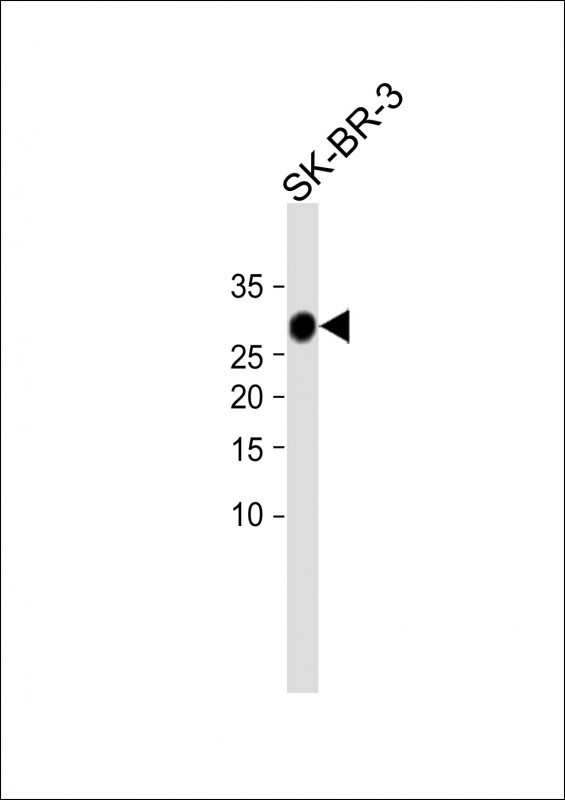DHRS2 Antibody (C-term)
Affinity Purified Rabbit Polyclonal Antibody (Pab)
- 产品详情
- 实验流程
- 背景知识
Application
| WB, IHC-P, E |
|---|---|
| Primary Accession | Q13268 |
| Other Accession | NP_878912.1 |
| Reactivity | Human |
| Host | Rabbit |
| Clonality | Polyclonal |
| Isotype | Rabbit IgG |
| Calculated MW | 29927 Da |
| Antigen Region | 197-225 aa |
| Gene ID | 10202 |
|---|---|
| Other Names | Dehydrogenase/reductase SDR family member 2, mitochondrial, 111-, Dicarbonyl reductase HEP27, Protein D, DHRS2 |
| Target/Specificity | This DHRS2 antibody is generated from rabbits immunized with a KLH conjugated synthetic peptide between 197-225 amino acids from the C-terminal region of human DHRS2. |
| Dilution | WB~~1:1000 IHC-P~~1:50~200 E~~Use at an assay dependent concentration. |
| Format | Purified polyclonal antibody supplied in PBS with 0.05% (V/V) Proclin 300. This antibody is purified through a protein A column, followed by peptide affinity purification. |
| Storage | Maintain refrigerated at 2-8°C for up to 2 weeks. For long term storage store at -20°C in small aliquots to prevent freeze-thaw cycles. |
| Precautions | DHRS2 Antibody (C-term) is for research use only and not for use in diagnostic or therapeutic procedures. |
| Name | DHRS2 (HGNC:18349) |
|---|---|
| Synonyms | SDR25C1 |
| Function | NADPH-dependent oxidoreductase which catalyzes the reduction of dicarbonyl compounds. Displays reductase activity in vitro with 3,4- hexanedione, 2,3-heptanedione and 1-phenyl-1,2-propanedione as substrates (PubMed:16685466). May function as a dicarbonyl reductase in the enzymatic inactivation of reactive carbonyls involved in covalent modification of cellular components (PubMed:16685466). Also displays a minor hydroxysteroid dehydrogenase activity toward bile acids such as ursodeoxycholic acid (UDCA) and isoursodeoxycholic acid (isoUDCA), which makes it unlikely to control hormone levels (PubMed:16685466). Doesn't show any activity in vitro with retinoids and sugars as substrates (PubMed:16685466). Attenuates MDM2-mediated p53/TP53 degradation, leading to p53/TP53 stabilization and increased transcription activity, resulting in the accumulation of MDM2 and CDKN1A/p21 (PubMed:20547751). Reduces proliferation, migration and invasion of cancer cells and well as the production of ROS in cancer (PubMed:29106393). |
| Cellular Location | Mitochondrion matrix. Nucleus. Note=A minor fraction of the protein is translocated from the mitochondria to the nucleus, after cleavage of the targeting signal |
| Tissue Location | Widely expressed, with highest levels in liver and kidney, followed by heart, spleen, skeletal muscle and placenta. In hemopoietic cells, expressed in dendritic cells, but not in monocytes, macrophages, granulocytes, nor in B and T lymphocytes |
For Research Use Only. Not For Use In Diagnostic Procedures.
Provided below are standard protocols that you may find useful for product applications.
BACKGROUND
DHRS2 displays NADPH-dependent dicarbonyl reductase activity in vitro with 3,4-Hexanedione, 2,3-Heptanedione and 1-Phenyl-1,2-propanedione as substrates. DHRS2 do not reductase activity is displayed in vitro with steroids, retinoids and sugars as substrates. This protein may inhibit cell replication.
REFERENCES
Monge, M., et al. Carcinogenesis 30(8):1288-1297(2009)
Persson, B., et al. Chem. Biol. Interact. 178 (1-3), 94-98 (2009)
Shafqat, N., et al. Cell. Mol. Life Sci. 63(10):1205-1213(2006)
终于等到您。ABCEPTA(百远生物)抗体产品。
点击下方“我要评价 ”按钮提交您的反馈信息,您的反馈和评价是我们最宝贵的财富之一,
我们将在1-3个工作日内处理您的反馈信息。
如有疑问,联系:0512-88856768 tech-china@abcepta.com.























 癌症的基本特征包括细胞增殖、血管生成、迁移、凋亡逃避机制和细胞永生等。找到癌症发生过程中这些通路的关键标记物和对应的抗体用于检测至关重要。
癌症的基本特征包括细胞增殖、血管生成、迁移、凋亡逃避机制和细胞永生等。找到癌症发生过程中这些通路的关键标记物和对应的抗体用于检测至关重要。 为您推荐一个泛素化位点预测神器——泛素化分析工具,可以为您的蛋白的泛素化位点作出预测和评分。
为您推荐一个泛素化位点预测神器——泛素化分析工具,可以为您的蛋白的泛素化位点作出预测和评分。 细胞自噬受体图形绘图工具为你的蛋白的细胞受体结合位点作出预测和评分,识别结合到自噬通路中的蛋白是非常重要的,便于让我们理解自噬在正常生理、病理过程中的作用,如发育、细胞分化、神经退化性疾病、压力条件下、感染和癌症。
细胞自噬受体图形绘图工具为你的蛋白的细胞受体结合位点作出预测和评分,识别结合到自噬通路中的蛋白是非常重要的,便于让我们理解自噬在正常生理、病理过程中的作用,如发育、细胞分化、神经退化性疾病、压力条件下、感染和癌症。






